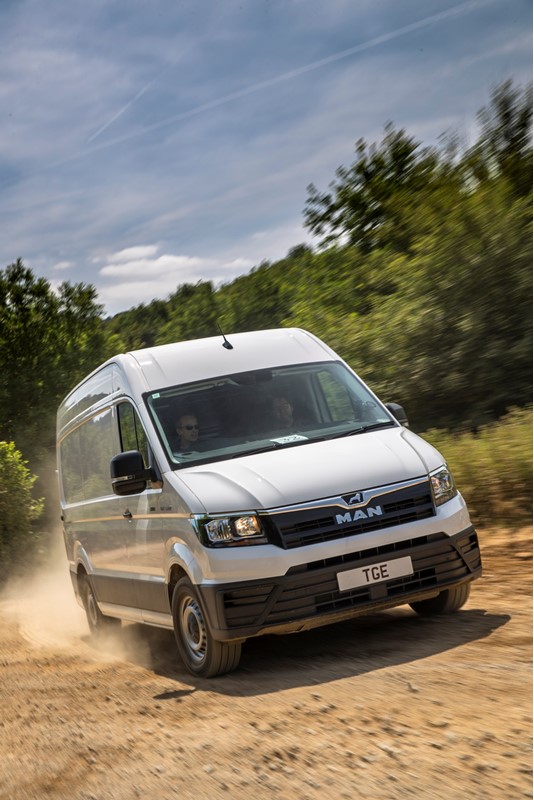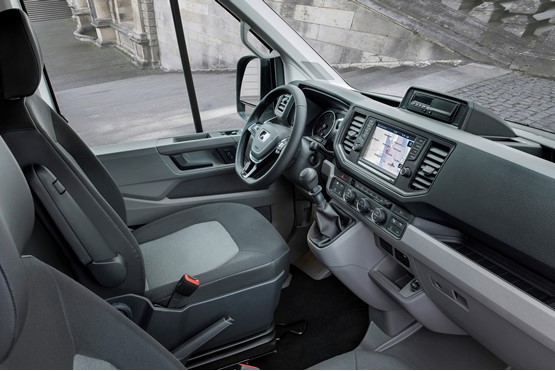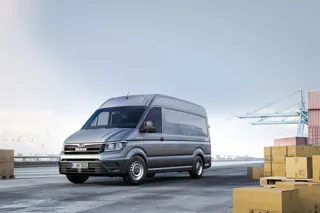Review
MAN's TGE van compares well thanks to truck-matching support package, Matt de Prez reviews
MAN refers to the TGE as “the truck among vans” and with the range now fully launched, fleet operators have numerous versions to choose from.
Following the launch of front-wheel drive 3.0- and 3.5-tonne versions last year, MAN has added rear-wheel drive and all-wheel drive options.
There is also an optional eight-speed automatic transmission, and the TGE can now be specified with a gross weight up to five tonnes.
The configurations are available across both the panel van and chassis cab.
The engine line-up consists of four versions of the same 2.0-litre diesel unit. Front-wheel drive versions are available with all four, with outputs ranging from 102PS to 177PS.
Rear-wheel drive can be specified with 122PS, 140PS and 177PS outputs, while all-wheel drive only comes on the 140PS and 177PS versions.
The eight-speed automatic transmission is also only available with the two most powerful engines, but across all driveline configurations.
As the MAN TGE is effectively a badge-engineered version of the new VW Crafter, the powertrains are identical.

This is no bad thing as the Crafter is a class-leader and gives the TGE the best possible start in life.
Between the two, the biggest difference is the way MAN sells and maintains the TGE.
Operators can expect the aftersales experience to mirror that of MAN trucks.
Service contracts can be tailored to a specific fleet, including out-of-hours servicing, and all TGEs come with 24-hour breakdown cover with a replacement vehicle guarantee.
Similarly, the buying experience is aligned to MAN’s truck operation and the vehicles are sold through MAN’s 64 UK dealers.
The rear-wheel drive TGE offers a more heavy-duty solution than the front-wheel drive version.
The additional weight of the drivetrain means it can carry 124kg less weight (140PS standard length version), with a maximum payload of 1,197kg.
It can tow more, though, with a maximum towing capacity of 3.5 tonnes.
All-wheel drive models also lose some payload (up to 130kg), dependent on which length is chosen.

In the back, the floor on rear-wheel drive and all-wheel drive models is 10cm higher, which robs 0.6 cubic metres of space overall.
There is slightly more vibration in the rear-wheel drive TGE, owing to its prop shaft, but this dissipates once there is some weight in the back.
Driving the TGE is a real pleasure. The interior is comfortable and well laid-out. Visibility is excellent, too, and a range of driver assistance systems are available.
Adaptive cruise control, lane-keep assist and automated parking can be specified to assist the driver.
Opting for the more powerful bi-turbo 177PS version delivers excellent performance, although we found the 140PS version is still more than adequate for fleet requirements and returns better fuel consumption.
We tried the eight-speed twin-clutch automatic gearbox for the first time in a TGE and it delivers a smooth and effortless drive, which should help reduce driver fatigue.
It changes gear with the precision you’d expect from a passenger car, with the option to manually control the box for engine braking or to hold gears when towing.
Prices vary dependent on version, but the automatic gearbox costs around £1,100 extra, according to the price list.
The all-wheel drive system provides greater traction, especially in adverse weather conditions. Again, prices vary dependent on configuration, but roughly increase by £2,000 over a front-wheel drive model.
Using a Haldex setup, the same as in the Crafter and a range of all-wheel drive road cars, the system is able to apply power to the rear wheels as required, giving the best balance of economy and performance.
We tested the TGE with all-wheel drive on a purpose-built off-road course.

Despite having standard suspension and road tyres, the TGE had no problems attacking the course and would be well suited to fleets that operate in rural areas.
Fuel economy will suffer slightly as a result of choosing all-wheel drive with published figures suggesting a loss of 1-2mpg.
Unlike Volkswagen, MAN offers no trim grades on the TGE. Fleets can specify the exact vehicle they require from the expansive options list.
As well as the driver aids mentioned earlier, the list includes speed limiters (56, 62 or 75mph), reversing camera, sat-nav, air conditioning, parking heaters, larger batteries and parking sensors.
On top of this is a range of bulkhead configurations and MAN has also announced a new approved conversions scheme, offering tippers, Lutons and dropsides.
While the price list appears daunting, with a truck mentality, it is merely a guide and fleets should be able negotiate a package to suit their requirements.
In terms of rivals, the new Mercedes-Benz Sprinter is set to take the TGE on head-to-head.
It brings new levels of connectivity to the sector and Mercedes-Benz is able to offer a similar truck-like support package to its LCV customers.
Verdict
The TGE is a no-nonsense vehicle that has been built to cover high mileages and operate in heavy-use scenarios.
It can be configured precisely to a business’s requirements and offers the highest level of aftersales support when compared with most other LCVs in the sector.
Model tested: MAN TGE 3.140 standard high roof rwd





















